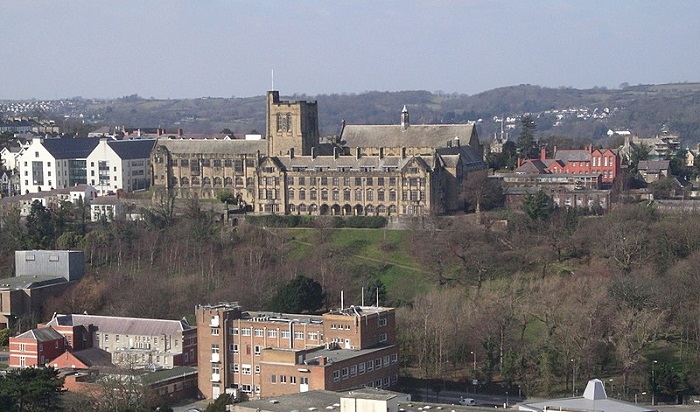About
Bangor is a small but lively university city located in Gwynedd, northwest Wales.
Known for its history and gorgeous architecture, Bangor is the oldest town in Wales and is filled with relics of the past, from its 12th-century gothic cathedral to its fairytale-worthy castles. However, the allure of Bangor does not lie solely in its history; it is also home to the longest zipline in the world.
History
Bangor’s origins can be traced back to the 6th century. Founded by the first Bishop of North Wales, St.Deiniol built a Celtic monastery here as early as 525AD; it would later become the site of Bangor Cathedral.
Aside from St.Deiniol’s monastery, Bangor was only a small settlement until the 18th century. From roughly 1785 to 1840, the town was located on the London-Holyhead-Dublin corridor, a route that stagecoaches used to deliver mail between London and Holyhead.
However, the town’s growth truly began with the development of the nearby Penrhyn Quarry. It became the largest slate quarry in the world by the end of the nineteenth century which, in turn, led to more workers moving into the area.
Bangor Now
Today, the city of Bangor is home to many attractions.
Zip World
Zip World is one of the biggest attractions in the area and is just a short drive from Bangor town centre. Velocity 2 is the fastest zip line in the world, reaching speeds over 100mph; it is also the longest zip line in Europe at 1.5km long.
The zip line travels over Penrhyn Quarry lake and the central quarry pit, which is 1200 feet deep and one mile long. The adrenaline rush, paired with the stunning views of Snowdonia, makes this a worthwhile stop-off whilst visiting Bangor.
If you visit Zip World, it is worth checking out Bounce Below too. An underground adventure park, Zip World is set in a network of caves and equipped with trampolines, slides and nets to clamber over.
Other adventurous activities for the family include Surf Snowdonia, a large surfing lagoon and GreenWood Family Park, filled with mazes, trails and even some rides.
Bangor Cathedral
The Cathedral of Saint Deiniol has a fascinating history.
The cathedral began as a monastery church, built in 525AD by Saint Deiniol. After he was appointed a Bishop of Gwynedd in 546 AD, his monastery church became a cathedral.
The building has been modified since, via a long history of lootings and invasions; the present building dates to the 12th century, with its elegant arches and enchanting gothic exterior.
The cathedral is open from 10:30 am to 4:30 pm.
The University of Bangor
Bangor is known as a thriving university city.
However, when the university was founded in October 1884, it only had 58 students. The university didn’t even have its own building until 1911, instead being hosted in an old coaching inn called the Penrhyn Arms.
In 1893 it became one of the three original colleges of the University of Wales; over 100 years later, the University of Bangor now attracts more than 10,000 students and 2000 members of staff every term.
The main building has become an attraction due to its views and interesting architecture.
Treborth Botanic Garden
Another attraction is the Treborth Botanic Gardens. 18 hectares of gardens are filled with woodlands, grasslands and rock shoreline habitat. Entire ecosystems exist within these gardens.
Overflowing plant borders lead to six greenhouses dedicated to orchards, cacti, and carnivorous vegetation.
There is even a Chinese Medicinal Garden as part of the Two Dragons Garden Project. It aims to showcase and research plants used in traditional Chinese medicine for over two thousand years.
The gardens have been owned by Bangor University since 1960 and are used for scientific research and teaching.
The gardens are free to access.
The Storiel
Picture: Courtesy of Storiel Museum
The Storiel is a museum and art gallery with a cafe opened inside the former Bishop’s Palace. A grade II listed building, the Bishop’s Palace is the second oldest building in Bangor – after the cathedral – dating back to the 16th century.
After two years of renovations, as part of a £2.6 million project, the Storiel was opened in 2016.
Exhibitions and displays of local artefacts tell a visual story of the town’s history; adjoining rooms are filled with contemporary artwork from local artists, contrasting these relics.
The seafront/ Bangor Garth Pier
Photo byTalsarnau Times, CC BY-SA 3.0, via Wikimedia Commons
Bangor has a relatively quiet seafront. The promenade offers a pretty view over the coast and leads north to Garth Pier.
Standing out against the coastline, this Grade II listed Victorian pier opened in 1893 and – at 470m long – it is the second longest pier in Wales.
The views from the pier are fantastic, looking over the Menai Strait waters to the Isle of Anglesey, with the backdrop of Snowdonia to the West.
It is worth taking a stroll down the pier and trying to catch the sunrise or sunset; You can grab a coffee en route from one of the pretty Victorian kiosks scattered along the pier.
It was voted Pier Of The Year by the National Piers Society in 2022.
Penrhyn Castle
This 19th-century castle is the gem of Bangor.
This sprawling castle was designed by the famous Victorian architect Thomas Hopper who – between 1819 and 1835 – blended a neo-Norman castle design with the pre-existing properties on the site, a medieval house and an 18th-century Gothic mansion.
The results were beautiful. A fusion of Neo-norman and victorian architecture compliments the gothic staircases and intricate carvings. Inside you will also find lavishly decorated rooms alongside an extensive classic art collection bearing the works of highly-regarded Dutch, Venetian and Spanish painters.
One hundred years earlier, this site was the home of the Pennants, an affluent family who owned several Jamaican sugar plantations and, by extension, slaves. The National Trust have been attempting to research and tell the darker stories of slavery around this castle.
The castle grounds contain pretty gardens and woodlands.



